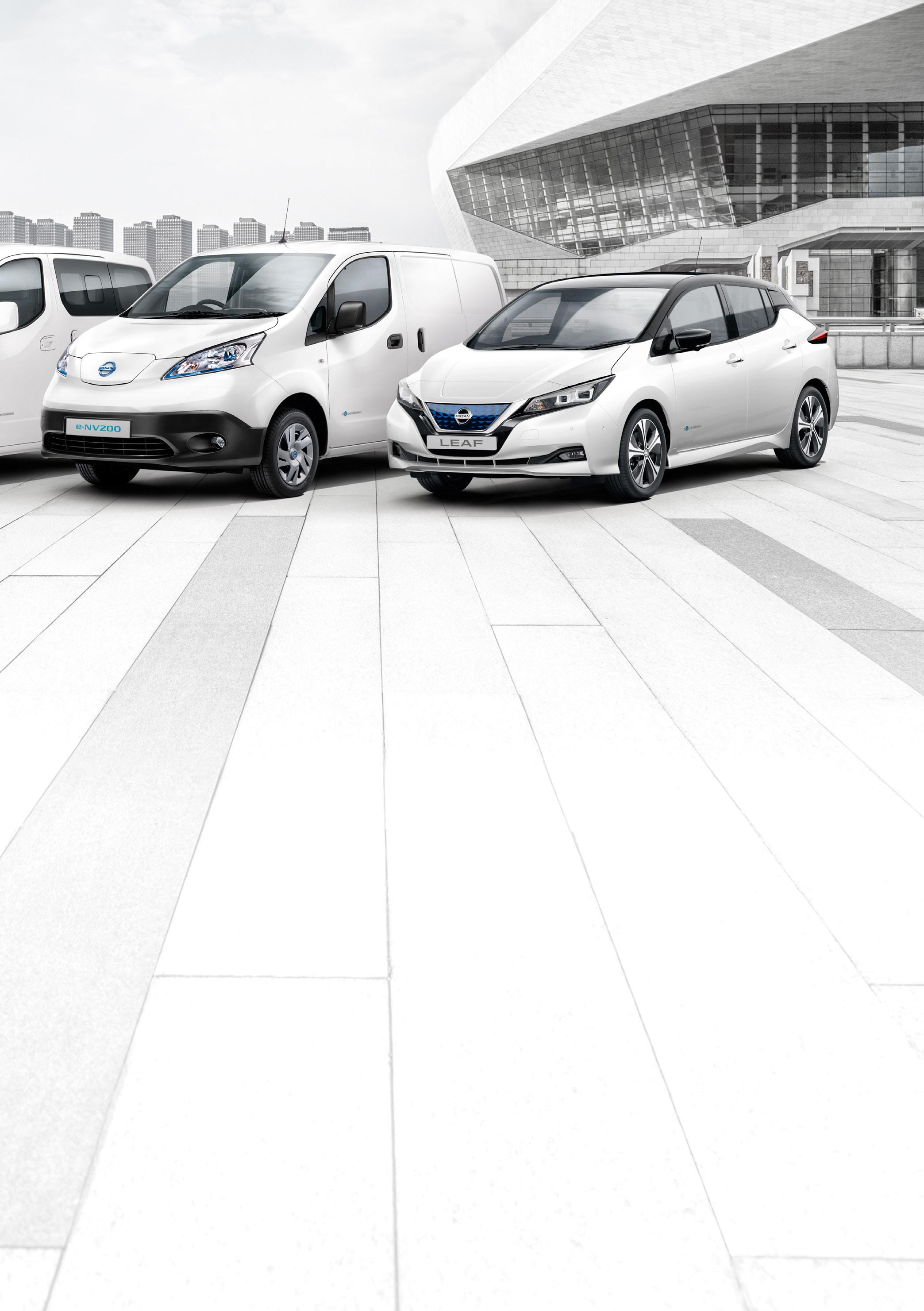
4 minute read
WHY GO ELECTRIC?
Good reasons to switch to 100% electric
Enjoy savings on tax, running costs and service, maintentance and repair
Advertisement
rganisations are adopting battery electric vehicles (BEVs) at an increasingly rapid rate as they switch on to the benefits – both environmental and financial – of the technology.
Latest registration figures from the Society for Motor Manufacturers and Traders (SMMT) show that 37,850 BEVs were sold last year, a rise of 144% compared with 2018 – a large jump although from a low start point.
This increase coincides with many of the obstacles which have traditionally put organisations off the technology – such as range anxiety, lack of charging infrastructure and vehicle availability – being overcome.
For example, the Nissan LEAF e+ has a range of up to 239 miles 1 on one battery charge, while in August 2019 the manufacturer published research that there were almost 1,000 more public places to charge EVs than there were forecourts to pump petrol in the UK – 9,300 EV charging locations compared with 8,400 fuel stations.
Although there are still lengthy waiting lists for many BEVs, Nissan has great stock availability of its LEAF, e-NV200 van and e-NV200 combi models in the UK, and is advertising “available today, drive away tomorrow”.
While the environmental benefits of BEVs are well documented, the financial case for adopting the O
technology is also strengthening for both employers and employees.
From April, the Government has announced that for the 2020/21 tax year, drivers of BEVs will pay 0% company car tax, increasing to 1% in 2021/22 and 2% in 2022/23*.
This means that, for example, in the 2020/21 tax year, a 20% taxpayer who drives a Nissan LEAF with a P11D price of £31,990 will save £1,663 a year compared with an identically priced petrol car with CO2 emissions of 105g/km (26% benefit-in-kind – BIK), and £1,791 over a 95g/km of CO2 diesel (28% BIK), with the same P11D price 2 . Employers also stand to gain from the new BIK rates. As the Class 1A National Insurance Contributions (NIC) for company cars is calculated using the BIK tax band, organisations will pay no Class 1A NIC on pure EVs.
Using the same cars as in the previous example, they will save £1,148 and £1,236* a year by opting for a BEV over an equivalent petrol or diesel model respectively.
In addition, BEVs are also exempt from vehicle excise duty (VED), while companies are able to claim first year allowances for charge point equipment bought. Operating pure electric vehicles also has a number of other financial benefits for fleets, with the running costs significantly cheaper than for comparable petrol or diesel cars.
BEVs are designed to be as efficient as possible and there are generally just three main components
powering the vehicle: the on-board charger, inverter and motor.
This is far fewer components than a petrol or diesel car uses, which means their wear and tear costs are significantly lower.
Cornish business C&C Taxis, for example, reports that over 174,000 miles and outside of scheduled annual services, one of its Nissan LEAF taxis needed just three sets of wipers, two sets of brake pads for the rear and one damper, as well as tyre replacements when necessary.
“With an equivalent diesel taxi doing that sort of mileage you’d be looking at things like replacing a clutch and that sort of work can see the vehicle out of the business for three days,” said Mark Richards, C&C transport manager.
“For us, that length of downtime can hurt the business, but we haven’t had that problem with the EV. The service and maintenance savings are impressive.” BEVs are also exempt from congestion and lowemission zone charges, while it also costs much less to ‘fuel’ a pure electric car. Dependent on the user’s electricity tariff, it could cost as little as two pence per mile (ppm) to drive a Nissan LEAF, compared with 9ppm to 12ppm for comparable diesel or petrol vehicles.
Mileage reimbursement will also cost an employer much less if employees use electric vehicles for business journeys.
The Government’s advisory fuel rates (AFRs) for a petrol car with an engine size of 1,401cc to 2,000cc is
FOR US, THE LENGTH OF SMR DOWNTIME CAN HURT THE BUSINESS, BUT WE HAVEN’T HAD THAT PROBLEM WITH THE EV Mark Richards, C&C Taxis

14ppm, while a diesel car with an engine of 1,600cc or less has a figure of 9ppm.
In comparison, the advisory electricity rate (AER) for fully electric cars is 4ppm. Using these rates, an employer would save £1,000 over 10,000 business miles.*
Government help is also available to organisations adopting electric vehicles. Its Office for Low Emission Vehicles (OLEV) offers a range of grants, including plug-in vehicle grants which go up to a maximum of £3,500 for cars and up to £8,000 for vans.
OLEV’s Workplace Charging Scheme is a grant that businesses can use to reduce the cost of installing charge points for staff by up to £10,000.
The grant is for £500 per charge point socket up to 20 sockets per applicant business and is available to any business, charity or public authority. Pod Point’s AC hardware, as well as its partner Delta’s DC rapid charger, is eligible for the grant scheme. * Source: Fleet News
1 Nissan LEAF 62kWh: Fuel consumption figures: CO2 while driving: 0 MPG Figures shown are for comparability purposes; only compare figures with vehicles tested to the same technical procedures. The electric range shown achieved using the new (WLTP) test procedure. Figures obtained after the battery was fully charged. Actual real world driving results may vary depending on factors such as the starting charge of the battery, accessories fitted after registration, weather conditions, driving styles and vehicle load.










